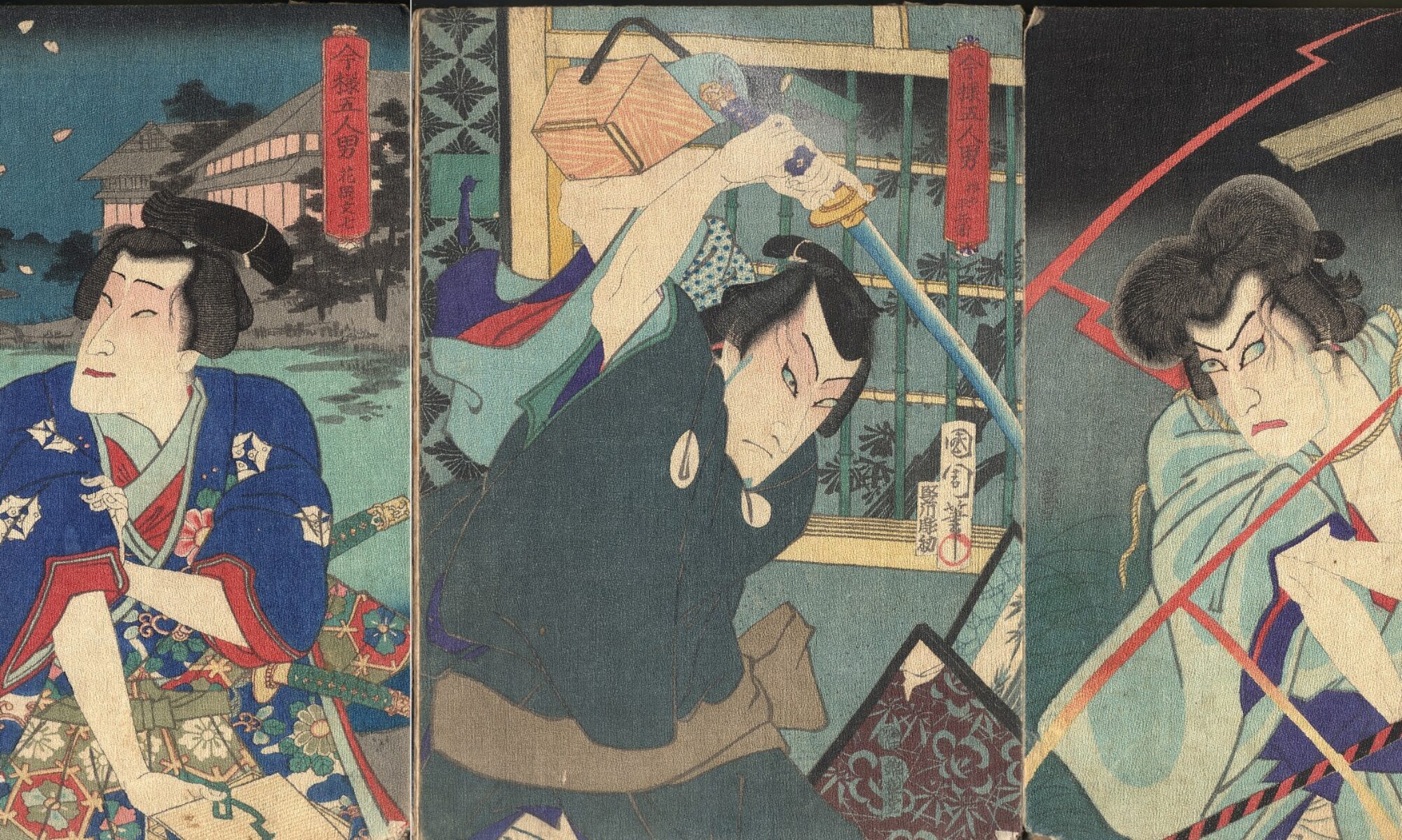Regarding the period from 1852 to 1870, the following was discussed: Changes in the artist’s surname before taking the name Kunichika Toyohara, Seal other than ToshidamaStamp, Ohkubi-e, Ohkao-e, compositions such as medium shots, emotional expressions, manga with exaggerations and omissions, storytellers, etc. Changes in censor stamps and surveys to confirm the year of issue.
.
Chapter 1 Changes in censor stamps and surveys to confirm the year of issue
It was necessary to arrange the early works in chronological order in order to investigate Kunichika’s style and activities. As part of kunichika’s early work, published works ranging from the 1850s to around 1875 were sought and the year of publication identified. Ukiyo-e, Kusazoshi paintings, Uchiwa-e paintings, etc. were all censored when he was active, so this information can be used to arrange Kunichika’s works in chronological order. However, it may be difficult to make a judgment based only on censor information. Iwakiri Yuriko(11) also describes the regulation of actor paintings due to the reform of Tenpo. From this, it was thought that the simultaneous description of the actor name and the cast name would be useful for determining the release year, so the information written in Ukiyo-e and Uchiwa-e was examined. Also, if the actor’s name is listed, the period during which he was known is known, and this information is useful for determining the year in which the ukiyo-e was painted. Of course, the daily report of the playhouse(12) is also useful. Here are some examples where information such as censor stamps, information content, and the presence of actors was examined to identify the specific year of release.
Kunichika’s works were selected by searching Ukiyo-e Search, Waseda University Theater Museum, ARC portal site (Ritsumeikan University), The Boston Museum of Fine Arts, , British Museum, Tokyo Metropolitan Library, National Diet Library Digital, etc. 1-1) Ukiyo-e, uchiwa-e, changes in the Censor System related to book illustrations, seal impressions of each era, and eto characters that changed in various ways were taken up, and these became the basis for determining the age. 1-2) Regarding the writing of cast names and actor names together, the release of Kunichika’s work was at a time when the restrictions on actor pictures that had been regulated by the Tenpo Reforms were relaxed and cast names and actor names began to be written together. I discussed the results of researching ukiyo-e and uchiwa-e because it was a useful time to judge the time when it was done. 1-3) Regarding identifying the year of publication of Ukiyo-e, it was discussed that the year of release of each work as determined by the holding institution differed from the information explained earlier.
1-1 Changes in the censor system
Basil Stewart(13), Ishii Kendo(7), Encyclopedia of Ukiyo-e in Primary Color Volume 3(8), Takahashi Katsuhiko(14) and others report on the history and imprints of censor stamps. Here, the censor stamp information of Ukiyo-e is based on the classification of Ishii Kendo, and is organized by adding other materials and the censor stamp information of Toyokuni III’s work and kunichika’s work. In addition, the censor system for Uchiwa-e was summarized with reference to the materials of Ishii Kendo. According to Article 21 of the New Publishing Ordinance revised on September 3, 1875, the censor system only states the name, address, and publication date, and the censor stamps so far have disappeared. Therefore, the information on the renewal that was used until then is no longer listed. As for ukiyo-e, kusazoshi, and uchiwa-e, it was investigated about the change of stamp from 1852 to 1875, which was the early period when Kunichika was active.
1.1.1) Ukiyo-e
Since there was a change in the censor system during the Edo period, the date when the ukiyo-e was printed can be estimated from the information stamped on the ukiyo-e. Since the censor stamp style differs depending on the era, Ishii Kendou divides it into eight periods as follows. Kunichika was active in the 5th to 8th periods and beyond.
First term : The era of the Kiwame「極」Stamp 1791~1842
It was between the 3rd year of Kansei and the 13th year of Tenpo (1791-1842), and was stamped with “Kiwame” to indicate that it was censored. The circle in the figure is Kiwame Stamp, and it is difficult to determine the year of publication, but it can be determined that the publication was during this period. It is rare that Eto/Month Stamp, and Gyouji Stamp were stamped during this period. The Kiwame imprint specifically showed various Kiwame characters in the 7th period Suham Stamp section of the 1.1.2) Uchiwa-e section.

Second term : One Nanushi Stamp era 1843~1847
It is between the 14th year of Tenpo and the 4th year of Koka (1843-1847), and one censored Nanushi Stamp is stamped. Ishii Kendo has confirmed Nanushi of 14 people (Fukatsu, Tanaka, Magome, Hama, Yoshimura, Mera, Takeguchi, Kinugasa, Muramatsu, Takano, Fukushima, Murata, Watanabe Shoemon, Watanabe Jiemon). In p129 of Volume 3 of the Encyclopedia of Primary Color Ukiyo-e(9), there are 13 people, overtaking Watanabe Jiemon. An example is the seal of Kinugasa Fusajiro.

.
Third Term: The era of Two Nanushi Stamps 1847~1852
It was between the 4th year of Koka and the 5th year of Kaei (1847-1852), and censor was carried out by two Nanushi. There were nine Nanushi (Hama浜, Magome馬込, Kinugasa衣笠, Murata村田, Mera米良, Fukushima福島, Muramatsu村松, Yoshimura吉村, Watanabe渡辺). An example is Hama浜 and Magome馬込 Stamps.
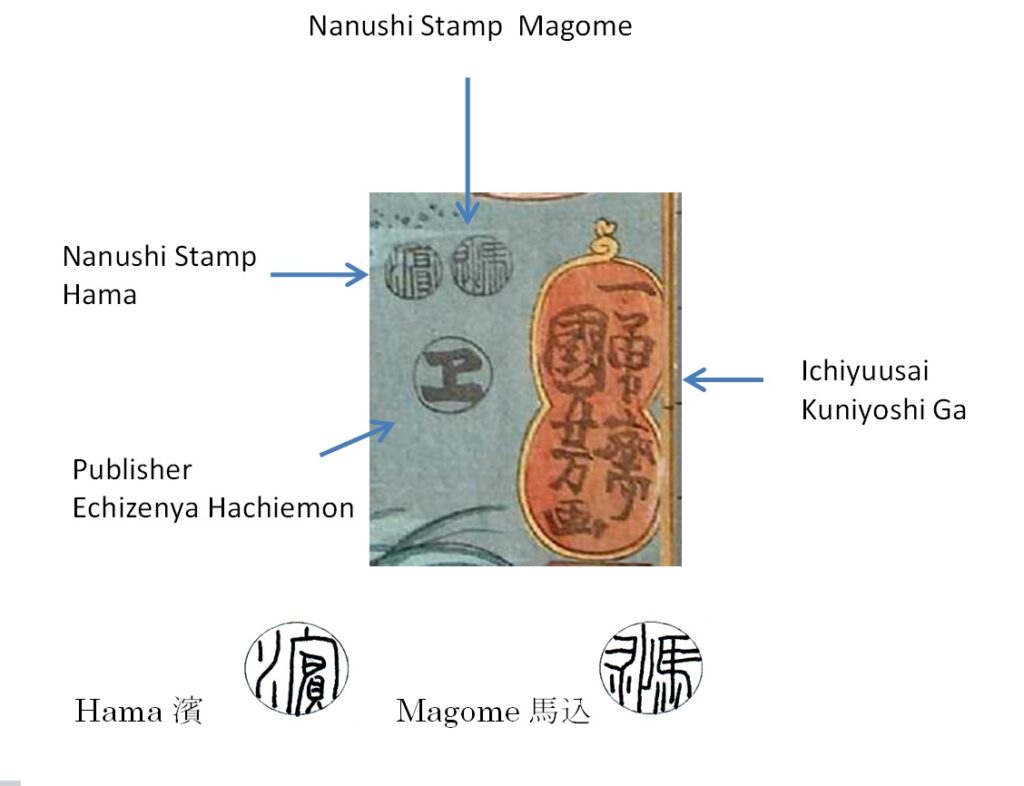
Fourth term: The era when Two Nanushi Stamp and Eto/Month Stamp were stamped. 1852~1853
It is a style between February 5th year of Kaei and November 6th year of Kaei (February 1852-November 1853). In this example, the Nanushi Stamp is stamped with two stamps, Kinugasa and Murata, and the Eto/Month stamp (August, Rat Year). Nanushi Stamp is a circle and has a large number of characters, so it is easy to distinguish because it is not the 5th term Aratame Stamp. This period is the year of the rat and the year of ox.

Mainly, the nine imprints of Nanushi Stamp, which appeared from 1847 to 1852, are illustrated.

.
Fifth term: The era when Eto/Month Stamp and Aratame Stamp were stamped 1853 ~ 1857
It is a style between Kaei 6th December and Ansei 4th December (December 1853-December 1857). In this example, the oval Eto/Month (February, tiger) and the round Aratame Stamp are pressed. This period is the year of ox, tiger, rabbit, dragon and snake.
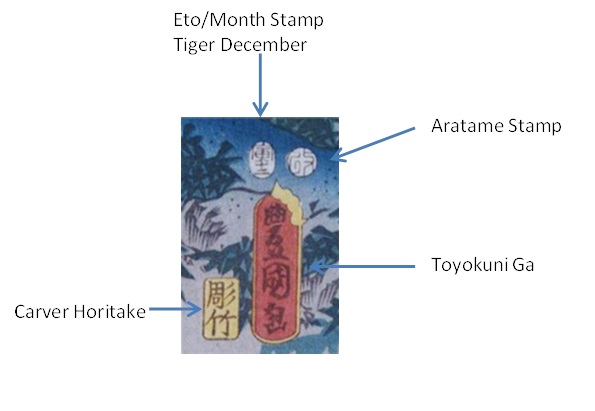
In the above example, the (Tiger year, December) Stamp and Aratame Stamp are stamped. In other years, the following marks are stamped.
./

.
Sixth term: An era of elliptical Eto/Month Stamps only 1857~1858
It is a style between December 4th Ansei and December 5th Ansei (December 1857-December 1858). During this period, there was only Eto/Month Stamp, an example showing that it was released in September of the horse year. This period corresponds to the snake year and the horse year. The imprint of this snake also has little change in font.

Seventh term: One Stamp era including Eto/Month/Aratame
The style between January Ansei 6 and the 4th year of Meiji (January 1859~1871). Eto has a 12-year cycle, but the characters of rat, oxs, snakes, and horses change little. The characters of dogs and boars changed drastically even in the same year, and the fonts changed considerably after 12 years. During this period, as shown in the example, for example, “Aratame” was written in the left half, “rat year” was written in the upper right, and “April” was written in the lower right.

.
.
Eighth term: The era of circular Eto/Month Stamp
It is the period from Meiji 5 to Meiji 8 (1872-1875), and the content is the same as the 6th period. The 6th period is an elliptical imprint, but this period is a round imprint. In addition, there are signs that seem to be freely engraved with other information. The characteristic mark is used in 1872 (Meiji 5). It looks like a carving that seems to be the year of a sheep or a monkey, but it is not a sheep but a Mizunoe Saru, which is an expression of Jikkan Juunishi. In this expression, MizunoeSaru has a cycle of 60 years, which in this case means 1872.

.
From 1873 until 1875, when legislation was established, this stamp system became ambiguous. In other words, the word “Aratame” used so far has disappeared. The letters indicating Eto and Month are stamped, but the letters “Month” have changed significantly, and the letters that give the impression that they do not necessarily represent “Month” are engraved. Even if the date of the performance is specified in something like Kabuki’s daily business report, there are many characters that indicate “Month” that cannot be read in that Month. Obviously, some characters that indicate Month can only be read from the month before the performance, and some imprints were thought to be printed at different times from the performance. During this period, the characteristics of Stamp are (1) no letters of Aratame改, and (2) Eto is clear. The year drawn from this feature can be clearly determined. The following is an example of the stamp that the display of the month seems to be appropriate from the flow so far for 1873 to 1875. However, during this period, the changes are quite drastic, and there are many characters that represent something other than the number of months, and some are indistinguishable. The abbreviations for holding institutions are Enpaku: Waseda University Theater Museum Digital, BMFA:The Boston Museum of Fine Arts, Tokyo: Tokyo Metropolitan Library, and the numbers behind them are access numbers.



.
Nineth term: After 1875
According to Article 21 of the New Publisher Ordinance revised on September 3, 1875, the name, address, publication date, etc. will be stated. In this example, outside the frame of Nishiki-e, the date of submission was described as the publisher Takekawa Seikichi, Horigin, etc. In Chinese characters that represent the year of this era, “23 years” is written as “廿三” and “35 years” is written as “卅五”.

The transition of stamps based on censor regulations has been explained in nine terms as described above. Specifically, the notation characters of Eto and Month will be described below.
Kunichika was born in 1835 and died in 1900. His work was last printed in 1903. Regarding this period, Ishii Kendo ‘s censor style, Christian era, era name, and Eto are summarized in Table 1. If Eto can be identified, the year can be narrowed down. Since the lunar calendar was used in the Edo period, the error with the solar calendar was corrected as a leap month. The leap month information is obtained from the website of the National Diet Library Internet Archiving Project and organized.
Next, Eto and Month are read from the imprint. However, even if one knows the kanji characters, the characters of Eto are transformed by taking advantage of their characteristics, and the characters of seal engraving are transformed. The characters of Month are designed by reducing the number of strokes and making use of the features of seal engraving. Regarding Eto, IshiiKendou states that it can be read by referring to the characters of Tenkoku, Nanatsu Iroha, Fugetsu Orai, and Old Edition Nanatsu Iroha. Table 2 summarizes the deformed and designed characters that can be used as a reference for understanding the Eto of Nishiki-e. In addition, Table 3 shows the transition of the Eto character for 24 years from 1852 to 1875. From 1852 to 1858, letters were engraved on the oval mark, and from 1859, Eto was also engraved on the circle. Looking at this Table 3, it can be seen that the font of the Eto character changed after 12 years. The most significant changes were in the year of the dog and the year of the boar. Table 4 summarizes the markings of the dog year and the boar year, which are likely to be confusing to read, among the Eto that actually appeared in Nishiki-e. The Eto signs overlap between 1859 and 1875 after the year 1859, but fortunately from 1872, as mentioned earlier, the word “Aratame” disappears, so determine which year the work is. It’s easy to do. However, although it is difficult to distinguish only in 1859 and 1871 sheep years, the fact that the fonts are different as shown here is a strong basis for discrimination. Also, the place where Eto is carved is not always the upper right in the imprint. The characters of ox and horse are also deformed considerably. Furthermore, as already mentioned, censor has disappeared since the 5th year of the Meiji era, and only notifications have been made.
Table 1 Ishii Kendo’s classification of censor, Christian year, the Japanese era, Eto, intercalary months

.
Table 2 Eto Character from old books
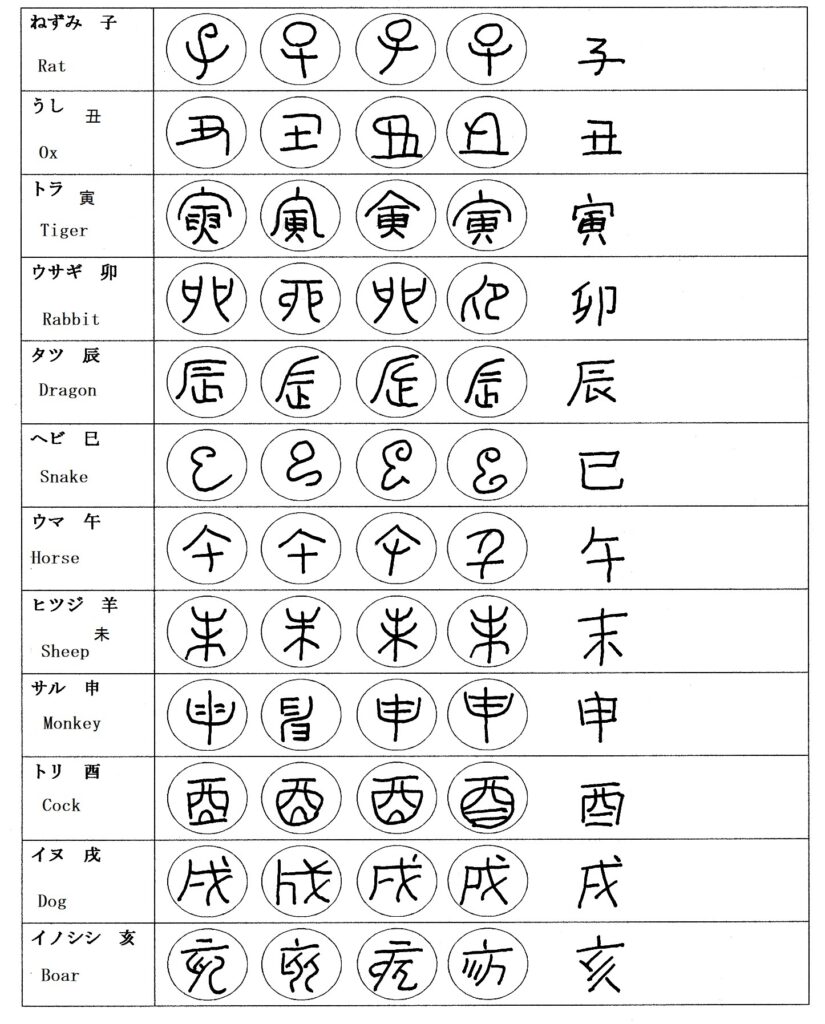
.
Table 3 Eto Character on Ukiyo-e
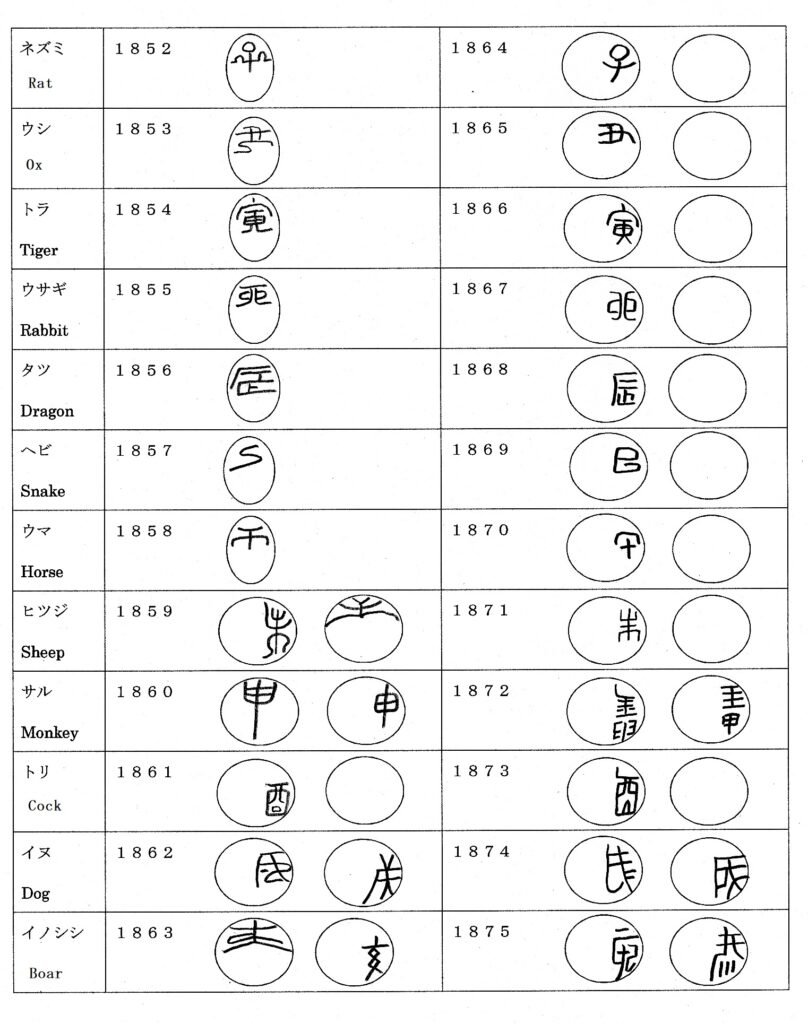
..

.
Table 5 Character of Month

.
Table 6 Character of Aratame

Table 5 summarizes the imprints actually used for the characters of Month. Month is represented by a number, but the letters are transformed and modified to show off the technique of engraving. The letters on the left side of Table 5 are the expressions around 1850, and the letters on the right side are the letters used in the era near 1875. However, there are cases where it is too elaborate to decipher. In the expression of January, “first” is not used, but “new year” is used. Other than that, Month transforms Chinese numerals. In April and June, there is a design that makes a difference whether there is a point on the top or not, and there are cases where it is not possible to conclude which Month it is. However, the writing style is constant depending on the times. The letters of Aratame are almost unchanged, so it is easy to understand. Most of it is drawn in the left half, but sometimes it is divided into left and right and other information is inserted between them (see 1.1.1 ,Seventh Term).
.
1.1.2) Uchiwa-e
The eto characters in the Uchiwa-e also have different impressions from those in the ukiyo-e. Specifically, it is shown in the seal of the Suhama stamp of the 7th period. This classification was based on Kendo Ishii’s materials.
First term ( ~1814)
The beginning of the censor of Uchiwa paintings is unclear, but the oldest is the 8th year of Bunka (1811). An era only for Aratame Stamp.
Second term (1815-1821)
It was an oval-shaped imprint with the letters Eto and Aratame written on it.
Third term (1822-1843)
There are two cases. In the first case, two marks, Eto and Kiwame, were stamped, and in the second case, an oval mark, which was a combination of Eto and Aratame, was used.
Fourth term (1843-1852)
An era when one or two Nanushi Stamps were stamped. The Nanusi Stamp is the same as that mentioned in the Ukiyo-e section. In this reference example, the characters of Yonekura are reversed.
An example of two Nanushi Stamps, Yonekura & Murata

Fifth term (1852-1853)
An era when a total of three stamps, two Nanushi Stamps and Aratame Stamp, were stamped. In this example, two stamps, Fukushima and Muramatsu, are stamped. The Suhama-shaped mark indicating Eto/Month indicates the year of the ox and February, that is, February 1853. The examples of the Suhama Stamp shown below are the Suhama Stamp in May 1852 and August 1852.


.
Sixth term (1854-1858)
The era when both the Aratame stamp and the stamp with Eto/Month written on the Suhama shape were stamped.

.
Seventh term (1858-1872)
The era of single stamps with the letters Eto and Kiwame in the shape of Suhama

All the characters of Kiwame are on the left side of Suhama form Stamp.

.
1.1.3) Illustration Related Works
As Kunichika’s early work, only the findings from 1855 to 1870 are described. The paintings on kusazoshi were always censored. The style is exactly the same as the style of Ukiyo-e. In other words, in the 5th period (1853-1857), Eto/Month Stamp and Aratame Stamp were stamped. Only the Eto/Month Stamp was stamped in the 6th period (1857-1858), and the Eto/Month/Aratame Stamp was stamped in the 7th period (1859-1871). The imprint is exactly the same as Ukiyo-e. In the preface of the kusazoushi and the combined volume of these books, the date of publication etc. is described. However, in many cases, the year the painting was censored is earlier than the year indicated.In other words, there are cases where it is thought that a picture was drawn, censored, and released the following year. Such an example was also seen in things such as those released over several years in a series of stories.
1-2 The simultaneous writing of the cast name and the actor name
1.2.1) Ukiyo-e case Yakusha-e, deregulation from Tenpo Reforms
From June 1842, due to the reform of Tenpo, the publication of actor pictures and nishiki-e of geisha customs was banned (11,p68). As a result, the play and Genji-e disappeared and changed to subjects such as samurai paintings, loyalty to the lord, filial piety, heroic stories, praise of extraordinary wonderful women, and lessons learned from wise women. In 1845, Mizuno Tadakuniwas dismissed from a key position in the shogunate, and the ban on Yakusha-e gradually became loose( 11, P104). For all of the above, it appears that actor paintings were not released for sale between about 1842 and about 1860, and even in art museums around the world, there are hardly any kabuki theater paintings with the actors’ names written on them on display. Therefore, even in art museums around the world, there are almost no paintings of kabuki plays with the actors’ names written on them that have been exhibited. Specifically, the paintings of Nakamura Utaemon in 1852, Ichikawa Danjuro 8th in 1854, Bando Shiuka in 1855, and Onoe Kikugoro 4th in 1860 remain.
Therefore, it was thought that knowing when the ukiyo-e with both the cast name and the actor’s name was released to the general public would be helpful in determining the year in which the ukiyo-e was released. Iwakiri Yuriko(11) states that “in 1863, the actor’s name and the cast’s name could be freely written together as an actor’s picture.” Therefore, it was considered that they were freely written together before 1863. Since Toyokuni III painted many actors, the ukiyo-e paintings in the Waseda University Theater Museum were examined from 1859 to 1861. In order to determine the date, (1) the date of issue was confirmed by examining the Aratame Stamp and Eto/Month Stamp, and (2) the conditions were confirmed that the actor was present and that the name was not vacant. On top of that, the number of records preserved in that year was examined. Works on Theater Museum Digital and the ARC portal site that were clearly different from Eto were excluded. The process is described. The cast and the names of the actors are listed, as in ‘Aburaya Okon as Sawamura Tanosuke’ published in 1859. The other one has the actor name ‘Kawarazaki Gonjuro’ written on it. Only 2 of the 850 sheets had this level of description, and many were just the cast names.
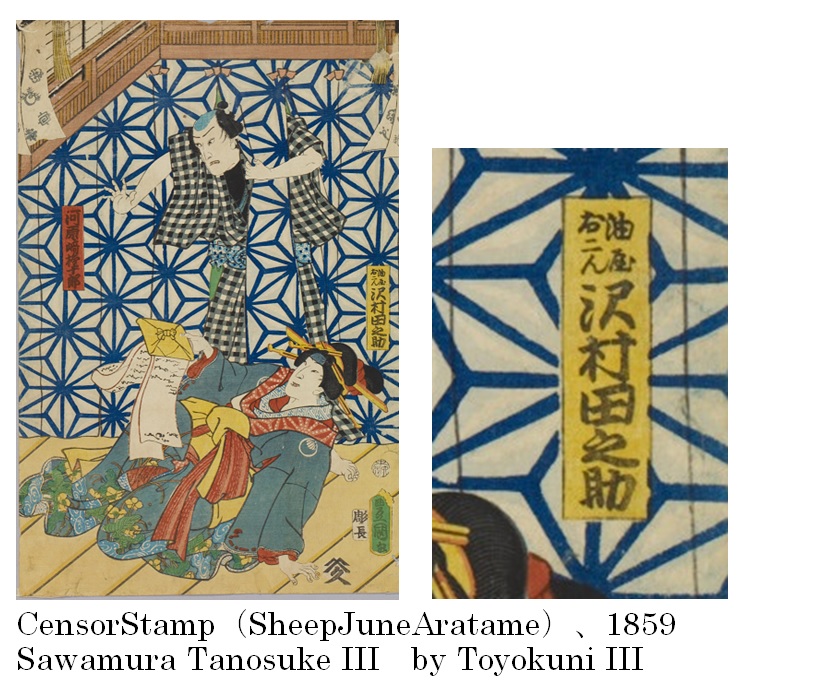
The next painting from 1860 states “Takeda Katsuyori, Bando Hikosaburo, April, Year of the Monkey.” In 1860, the cast list was small and the actor names were large. This nishiki-e has clean lines and a strong impression, and looks like a work by Toyokuni III from a slightly later period, but since Toyokuni III died in 1864, it is thought to have been created in 1860. The date and month stamp on this painting is inverted. It is thought that it was possible to carve it on the wrong side. As mentioned above, of the 674 nishiki-e by Toyokuni III stored at the Waseda University Theater Museum, only three from 1860 quietly listed the cast and actor names. In the ARC portal, 17 out of 616 had the cast and actor names listed.

However, as shown below, from 1861 there was a sudden increase in examples where the cast names and actor names were written separately, suggesting a liberation from the long-standing restrictions of the Tenpo Reforms. In the following example, it reads “Azuma no Yoshiro Kawarazaki Gonjuro” and “Yaegaki Hime Sawamura Tanosuke.” Writing in this way, with both the actor’s name and the cast name written side by side, had become common by 1861.


1.2.2) Uchiwa-e case
Regarding Uchiwa-e, the following three albums are stored in the National Diet Library Digital.
- Yakusha Nigaho Uchiwa-e Fan National Diet Library No.237-376
- Actors’ Uchiwa, National Diet Library No.237-377
- Uchiwa painting, National Diet Library 特56-37
Among them, the contents were investigated using the “Haiyu uchiwa-e”, which has a wide collection period. The date determination was described in 1.1.2) the case of fan paintings. This document, which was obtained from the National Diet Library Digital Library, contains 155 fan paintings by popular artists such as Toyokuni, Kuniyoshi, Kunichika, and Fusane. The recorded works were from the 4th term (1843 to 1852) to the 7th term (1858 to 1872). The 4th term cannot be specified more than between 1843 and 1852. There are also pictures of plants, etc., and not all of them are actor pictures. The censor stamps of the works with both the cast and actor names were examined, and the Uchiwa-e with both were 1861, 1862, 1863, 1864, and 1865. The work of 1861 was published on each page of 35, 36, 37, 38, 39, 94, 103, 125, 126, 127 out of 160 pages. All of these included the cast name and the actor name. Specifically, the picture of Toyokuni III on page 103 of “Haiyu uchiwa-e” describes the cast and actor names, such as Kawarazaki Gonjuro as Yuruki Saemon and Sawamura Tasuke as Kozakura. However, the 1860 work is on each of the 4, 23, 24, 27, 28, 33, 76 pages of the 160 pages of this material. In each case, there was only a description of the cast name, such as Ushiwakamaru and Jorurihime.
In this way, before 1860, only the cast name was described, so it was thought that it became easier to freely write the actor name and cast name from 1861. As mentioned above, it was not possible to write the actor name and the cast name together in the actor picture and the uchiwa-e after the reform of Tenpo, but in 1861, in the field of uchiwa-e, as well as the field of ukiyo-e, it was free. It can be seen that it came to be written together in 1861.
1-3 The identification of the year of issue
In the process of selecting ukiyo-e in chronological order for the purpose of examining Kunichika’s early works and checking whether the year of creation of the work was correct, there were some cases that differed from the judgment of the holding organization. Here is the rationale for determining which year seems to be correct.
1.3.1) Nakamura Shikan as Shirabyoushi 1871 Waseda University Theater Museum 007-0149

①Eto/Month / Aratame Stamp
There was a holding institution that judged this work to be published in 1859. Eto/Month/Aratame Stamp is April of the year of sheep. The years of sheep when Kunichika was active were 1835, 1847, 1859, 1871, 1883, and 1895. Kunichika was introduced to Toyokuni III in 1848 or 1851, so his nishiki-e was painted after 1852. Also, after 1872, this type of Censor stamp was not used and changed to a year/month stamp. Therefore, it is not after 1883 of the sheep year. From this, it is shown that this Eto/Month/Aratame Stamp information is a work of 1859 or 1871, but no more can be specified by the stamp.
②Kabuki actor Nakamura Shikan Casting Shirabyoshi
In this actor picture, the actor’s name is Nakamura Shikan and the cast is Shirabyoshi, so it seems to be a scene from Dojoji from the cast name. In a similar Nishiki-e, a similar scene is drawn at Tosei Musume Dojoji in 1867. By the way, when examining Nakamura Shikan, Nakamura ShikanIII inherited his name in 1836 and died in 1847. Nakamura Shikan IV was a popular actor who was named in 1860 and was active until 1899. In other words, from 1847 to 1860, the name of Nakamura Shikan was vacant. The database of ARC portal site (15) was used for the name period of the name. Also, from then on, the ARC portal site was referenced for all the name periods. Since the year when Nakamura Shikan was active was the year of the sheep after 1860, it was concluded that this work was a work of 1871.
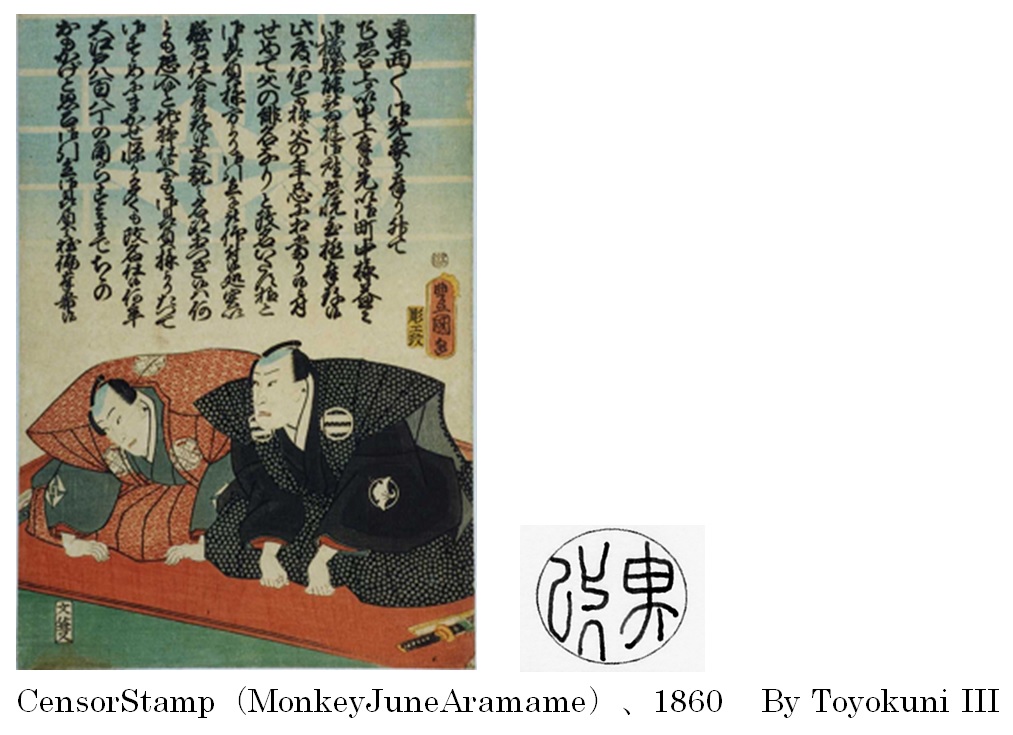
For reference, Ukiyo-e when Nakamura Shikan took the name of the 4th generation in 1860 is introduced. It was published in June of the year of the monkey, so it is a work of 1860. On the right is Kataoka Nizaemon’s 8th generation, and Nakamura Shikan (left) is wearing the Gion Mamoru crest.
③ Both actor name and cast name
As a result of examining the preserved actor pictures as mentioned above, the actor names and cast names have been freely drawn in Ukiyo-e since 1861. It can be seen that this picture is a work of 1871, because the picture showing the actor’s name and the cast’s name is after 1861 like this picture.
④ Kabuki Chronology Volume 7(12)
There is a record that Shikan played the role of Sakurako and Hikosaburo played the role of Hanako at the Ichimura-za Theater in September 1871 as道成寺一封振袖.
1.3.2) Uchikago sogataimen no zu 1871 Ouju Toyohara Kunichika Waseda University Theater Museum 007-1663、007-1664、007-1665

Drawn from the Censored Stamp (Sheep Jan.Aratame) in this painting is the Year of the Sheep, and from the style it is a work of 1859 or 1871. Although it is a letter of Month, it has a shape that is difficult to interpret. However, this letter was not understood as October and was considered a variant of January. There is a round-headed “正” similar to this in the form of January. In addition, the performance “Soga” is considered to be performed in January, as many performances are performed on New Year’s Day.
As for when this painting was released, I am interested in two things. The first is the painter’s name, which is written as ‘Ouju Toyohara Kunichika.’ Kunichika had published several works by 1858, but he used the painter’s name such as Ichiusai Kunichika and Kachoro Kunichika, but did not use the surname Toyohara. So, it may be the first work that uses the Toyohara name. Currently, he is recognized as ‘Toyohara Kunichika’ in the world of ukiyo-e, but he calls himself Ichiousai Kunichika in his works at the time of his debut. In the field of illustrations, Kunichika used the name Utagawa Kunichika in ‘Yoshinaka Yusenroku’ in 1856, but this painter’s surname ‘Utagawa’ is rarely used in the field of ukiyo-e. This is an important matter in confirming when he started calling himself ‘Toyohara Kunichika’ in the field of ukiyo-e. The second point is “Ouju”. “Ouju” means that the painting was sponsored and commissioned. In other words, it shows that he was popular as a painter and was highly evaluated. If this is a work of 1859, it is thought that it shows that the popularity was already established shortly after the debut. Regarding ‘Ouju’, ‘Takukai Sake Banquet’ in 1863 is considered to be the first. If this painting is from 1859, it would indicate that it was beginning to become popular, or was gaining recognition, much earlier than was thought. The above two points, the timing of the use of the name Toyohara Kunichika and the timing of the demanded works, are important when considering Kunichika’s early activities and evaluation.
The cast and names of the actors in the painting should also allow us to determine the year it was created, but as you can see below, 1859 doesn’t make sense. In 1859, there are no actors using the names of Nakamura Shikan and Ichikawa Sadanji, so I would like to conclude that this work was written in 1871. However, according to “Ichikawa Danjurou for generations”(16) by Hattori Yukio, in 1871 there was no actor calling himself Kawarazaki Gonjurou. Therefore, I investigated whether this name appeared in ukiyo-e prints from around 1871 to 1874.
| Actor | 1859 | 1871 |
| Nakamura Shikan | Vacancy | 4th(1860name succession~1899) |
| Kawarazaki Gonjurou | First (1852~1868)~1874 | |
| Ichikawa Sadanji | Not Exist | First(1864~1904) |
| Toshou | Second | Second |
| Mitsugorou | 5th(1856~1872) | |
| Shijaku | Second(~1861) | 3rd(1861~1881) |
| Hikosaburou | 5th | 5th |
| Kikugorou | 4th(~1860) | 5th(1868~) |
According to Hattori Yukio(14), Kawarazaki Gonjuro worked under this name from 1852 to 1868, and in March 1869 he assumed the name Kawarazaki Gonnosuke, and in September 1873 he changed his name to Kawarazaki Sanshou. He says that in the year after July 1874, he assumed the name Ichikawa Danjurou ninth. Therefore, when the actor’s name is searched in databases such as ukiyo-e search, paintings of Gonjuro appear in the 1860s. In the 1870s, Kawarazaki Gonnosuke and his Kawarazaki Sanshou actor paintings appeared.
However, from 1871 to 1874, there were actor paintings that clearly stated Kawarazaki Gonjuro. Next, a picture of Gonjuro Kawarazaki from 1872 is introduced. It is difficult to understand what the left side of the censor stamp of this work means, but it seems to be the word “Aratame”. The right side is the notation of “JikkanJuunishi 十干十二支” which is unique and used only this year. It is 1872 because the character design of “Mizunoe Saru 壬申” is used in . A painting from 1874 is introduced. The Censor Stamp of this picture has already been shown as an example of 1.1.1) 8th Period February 1874 Year of the Dog. In this way, Gonjuro’s name is still used in ukiyo-e even after he changed his name. Even after the name was no longer used in theaters, it is thought that it was still used in the public. And, in 1875, Gonjuro’s paintings of actors did not appear.
Thus, the names of actors officially changed as described by Hattori Yukio . However, it seems that the popular old name “Kawarazaki Gonjuro” was still used. In that case, it can be seen that all the actors in the picture were active in 1871, so the picture of “Uchikago Soga no taimen” was painted in 1871.
In the Kabuki chronology(12), there is a record of魁道中双六曽我at Nakamura-za in January 1859, 小袖曽我薊色縫at Ichimura-za in February, and三国一山曽我鏡at Morita-za in January 1871. However, the details of the names of the actors and the cast were not included, so it was not helpful in making a decision.


1.3.3) Isamihada migakinoudezoroi 1871 Toyohara Kunichika Waseda University Theater Museum 007-1055, 007-1056, 007-1057
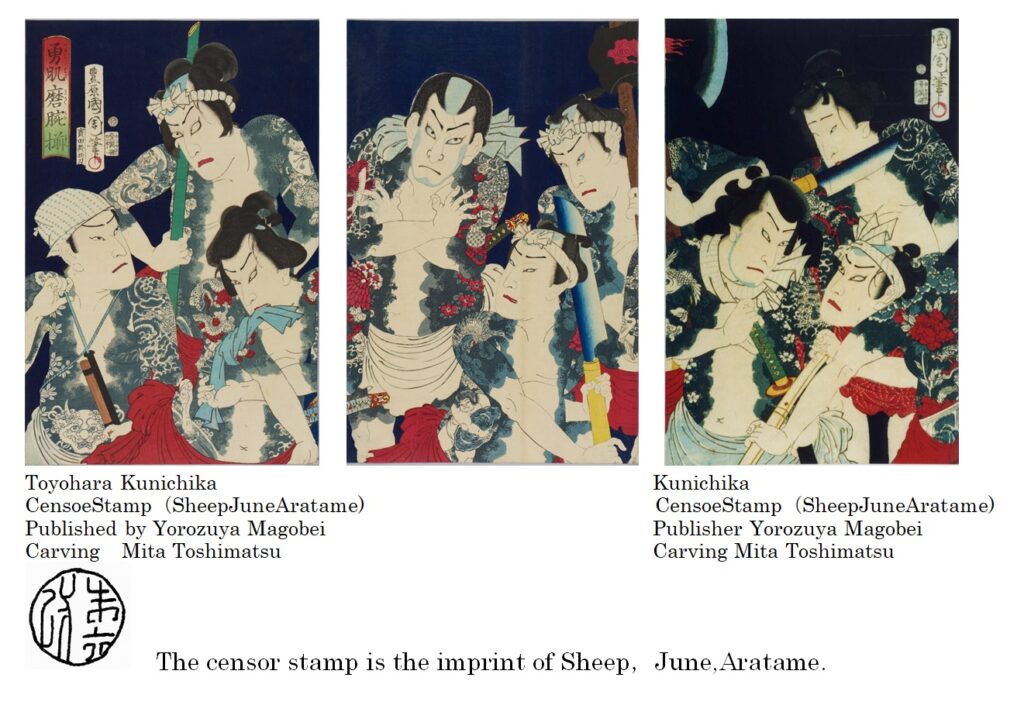
Triptych, a young man with tattoos. The year of this work may be from the form of the Censor Stamp from 1858 to 1871, of which the sheep years are 1859 and 1871. As mentioned earlier, in this work he called himself “Toyohara Kunichika”, so the year it was released was examined with particular care.
① A picture like this without actor names or cast suggests the possibility that it is a work during Tenpo’s reform. However, since the ukiyo-e with only the cast name was drawn even after 1861, nothing can be judged from this alone.
② It is said that Waseda University Theater Museum has not finalized this picture’s published year, but the names of the actors not drawn in the picture are listed. However, if the actor’s name is correct, the actor’s name will not be available unless it is a work of 1871. Onoe Kikugoro V was named in 1868 and Ichikawa Danjuro IX was named in 1874, so both of them were absent in 1858. On the other hand, Bando Mitsugoro VI and Bando Hikosaburo V existed in each year.
③ The publisher of this picture is Yorozuya Magobei. Therefore, the Publisher relationship between Kunichika and Yorozuya Magobei was examined in the ARC portal site. In the ukiyo-e stored in ARC portal site, 293 works of Kunichika were released from Yorozuya Magobei. Initially, there were three works in 1865, and after that, it was published stably until 1883. It peaked in 1874, but it seems that the number of publications was small in 1871. The table shows the changes in the number of publications, but it may be biased due to collection problems, but it is unlikely that Yorozuya Magobei published only one piece of this work in 1859 from this table. It was thought that the work of 1871 would be possible.
④ Eto’s sheep typeface, but as shown in Table 3, the sheep typeface has changed with the times. This change is acknowledged by Ishii Kendo, but the typeface of the sheep stamped on this work can be judged to be the typeface of 1871.
⑤ Kabuki chronology(12) Vol. 7, in March 1871, there is a record of the performance ”名大津画劇交張” as a joint performance of the Morita-za and the Ichimura-za. Since the names of 11 actors, including Shikan, Tosshou, Mitsugoro, Uzaemon, and Gonnosuke, are listed, it was thought that this was an ukiyo-e. From the above, this ukiyo-e was judged to be a work of the sheep of 1871.
Number of Kunichika works published by Yorozuya Magobei
| Era | Yaer | Number of works |
| Gangi 2nd | 1865 | 3 |
| Meiji 1st | 1868 | 35 |
| Meiji 2nd | 1869 | 63 |
| Meiji 3rd | 1870 | 22 |
| Meigi 4th | 1871 | 6 |
| Meiji 5th | 1872 | 27 |
| Meiji 6th | 1873 | 37 |
| Meiji 7th | 1874 | 73 |
| Meiji 8th | 1875 | 24 |
| Meiji 16th | 1883 | 3 |
1.3.4) Mashiba Hisaaki as Ishikawa Goemon 1867 Kunichika painting Waseda University Theater Museum 101-0829、101-0828

This work, which was classified in 1860, is difficult to see in this picture, but there is a censor stamp above Kunichika’s brush on the picture on the left, which was (RabbitAprilAratame). Therefore, it is a work of 1867. In addition, in the 7th volume of the Kabuki chronology, there is a description that真紫久秋played 石川五右衛門 in the play “石川五右衛門” at the Nakamura-za in February 1867.
1.3.5) Heroic magic competitions 1873 Toyohara Kunichika painting National Diet Library digital 本別7-537
About five series of heroic magic competitions were stored in the National Diet Library. All the works are written so that the names of the actors and the cast can be understood, indicating that the regulations due to the reform of Tenpo have been relaxed. The way the face is drawn is rounded and gives a cartoon-like impression. The National Diet Library classified these five works into 1861. However, the censor stamp was the 8th style described in the case of Ukiyo-e, and it was a work of 1873 because it did not have the letters Aratame and was stamped with the Cock / December stamp. The publisher is Hacchoubori Matsuei(八丁堀松栄).


Gouketsu Kijutsu kurabe Kawarazaki Gonjurou as Jiraiya
Although it says December, the year of the cock, it can be judged to be 1873 because there is no Aratame character. Publisher:Hacchoubori Matsuei


.
1.3.6) Nakamura Shikan Toyohara Kunichika painting From Artelino
Published by Yorozuya Magobei, who is the same as勇肌磨腕揃. Since there is no Aratame character on the stamp and it indicates the year of the cock, it is considered to be a work of 1873. See the imprint of the 8th period. Kabuki Chronicles, Vol. 7 (12), in February 1873, at the Nakamura-za Theater, there is a description that Nakamura Shikan played Ukiyo Todaira in the play “Kyokyaku Sugata Nishiki-e”.

.
1.3.7) Kotobuki nagorino shimadai(寿名残嶋台) 1871 Kunichika painting Waseda University Theatre Museum No. 007-1654、007—1655、007-1656
This work was classified in 1859. The censor stamp is the year of the sheep/April/ Aratame, which is either 1859 or 1871 from this style. The actor’s name will be Bando Hikosaburo 5th, Onoe Kikugoro 4th in 1859, and Onoe Kikugoro 5th in 1871. Therefore, the year of release cannot be determined by the actor’s name. The title says “Kamezo Issei Ichidai”, which indicates that this is a big hit played by Kamezo. Therefore, the program “寿名残嶋台” was investigated. Then, it turned out that March Meiji 4 was the premiere(12), so this work was made into an ukiyo-e that was performed in 1871.

.
